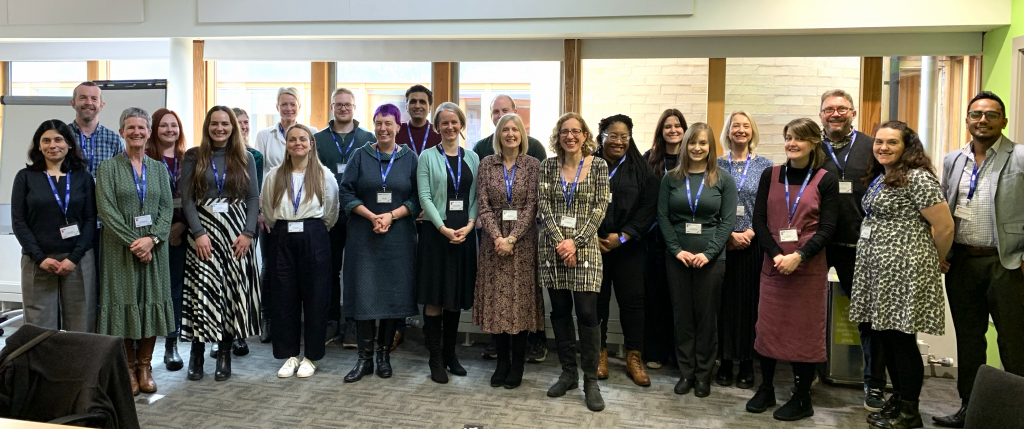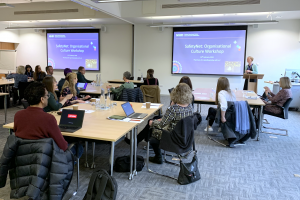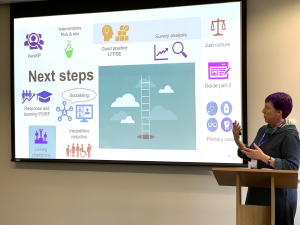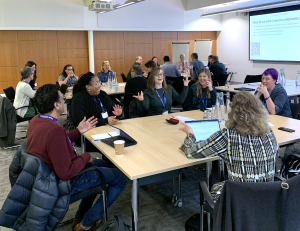
SafetyNet Organisational Culture Workshop brings together PSRC researchers in an exciting new collaborative space
By Maria Zubair and Joy Spiliopoulos
On the 14th of February 2024, the NIHR Greater Manchester Patient Safety Research Collaboration (GM PSRC) hosted the first NIHR PSRC Network (SafetyNet) workshop on organisational patient safety culture. Being co-led by GM PSRC research leads based at the University of Leicester, together with Yorkshire & Humber (YH) PSRC colleagues, the NIHR SafetyNet Organisational Culture Workshop was an inspiring platform for reflecting on current research being undertaken in the area of organisational cultures of safety, thinking about future directions for research in this area, and bringing together researchers from across the PSRCs in a new and emerging collaborative space. Alongside representatives from the six PSRCs across England, we were honoured to have Professor Siri Wiig, from the University of Stavanger, Norway, an internationally renowned expert in the fields of organisational culture and quality and safety in healthcare, who provided important insights into the group discussions throughout the day.
 The workshop was co-chaired by Professors Natalie Armstrong and Carolyn Tarrant from the GM PSRC and Professor Jane O’Hara from the YH PSRC. The chairs opened the event by welcoming delegates and identifying the objectives of the workshop, which included mapping relevant current and planned research across the PSRCs, identifying key synergies and shared interests and priorities for future work, and agreeing how to take the group forward following on from the workshop. It was noted that, as part of these overarching objectives, an important purpose of the workshop was also to consider how SafetyNet can provide an important means for developing a mutual support network for PSRC researchers interested in research on organisational cultures of safety. Some further important questions identified for researchers to reflect on during the course of the day were regarding how the group may collectively challenge itself – including thinking about and identifying what were some of the difficult and provocative questions that needed to be asked or the ‘too hard’ problems that were not being tackled currently.
The workshop was co-chaired by Professors Natalie Armstrong and Carolyn Tarrant from the GM PSRC and Professor Jane O’Hara from the YH PSRC. The chairs opened the event by welcoming delegates and identifying the objectives of the workshop, which included mapping relevant current and planned research across the PSRCs, identifying key synergies and shared interests and priorities for future work, and agreeing how to take the group forward following on from the workshop. It was noted that, as part of these overarching objectives, an important purpose of the workshop was also to consider how SafetyNet can provide an important means for developing a mutual support network for PSRC researchers interested in research on organisational cultures of safety. Some further important questions identified for researchers to reflect on during the course of the day were regarding how the group may collectively challenge itself – including thinking about and identifying what were some of the difficult and provocative questions that needed to be asked or the ‘too hard’ problems that were not being tackled currently.
Aligning with NHS England priorities on safety culture

Dr Hester Wain, Head of Patient Safety Policy at NHS England
We were delighted to have Dr Hester Wain, Head of Patient Safety Policy at NHS England, as our keynote speaker for the workshop. Hester’s presentation focussed on the current challenges and future vision for safety culture within the NHS, hence setting out some of the relevant policy context (and recent shifts therein) in relation to the organisational cultures of safety within the NHS. Acknowledging the challenge around addressing how patient safety and patient safety cultures have traditionally been understood and defined, Hester suggested a definition of patient safety culture that has been co-produced with patients and the public as well as clinicians, whereby: “Positive safety culture is defined as one where the environment is collaboratively crafted, created and nurtured so that everybody (individual staff, teams, patients, service users, families and carers) can flourish to ensure brilliant, safe care by: Continuous learning and improvement of safety risks; Supportive, psychologically safe teamwork; and Enabling and empowering speaking up by all”.
Hester also highlighted the need for developing nuanced understandings around organisational safety cultures and safety work as it pertains to (and/or is understood within) different care settings and different professional groups. Furthermore, emphasising the importance of the use of co-production in developing effective initiatives around positive patient safety culture change, she identified the PSRCs as presenting a good opportunity for undertaking co-production and co-design activities. Hester’s insightful and engaging talk was followed by a lively group discussion around issues pertaining to the operationalisation of patient safety cultures, capturing and inclusion of the patient voice when defining and determining organisational cultures of safety, and the challenge of implementing positive cultural changes in the context of constrained resources and increasing pressures on health and care staff.
Hester’s presentation covering the policy context, was complemented by the next part of the workshop programme involving University of Leicester-based members of GM PSRC along with members of YH PSRC presenting an overview of the relevant organisational culture research being undertaken within their respective PSRCs. Professor Natalie Armstrong, the co-lead for the GM PSRC’s Enhancing Cultures of Safety (ECoS) theme, identified some of the areas of interest shaping work within the GM PSRC’s ECoS theme as including voice and speaking up, workplace wellbeing, regulation and governance of safety, incident investigation capacity and capability, implementation of safety guidelines in practice, and effective leadership for safety. Professor Jane O’Hara talked about the Safer Systems, Cultures and Practices theme based within the YH PSRC which involves a focus on questions around how to measure or conceptually define organisational culture. Researchers from all PSRCs represented were also invited to present the aims and objectives of their ongoing projects which address challenging issues within organisational cultures in healthcare.
Where do we go next?
 Following on from the policy and research focussed presentations, which prompted some very insightful discussions and reflections from the group, the second half of the workshop led nicely into two roundtable discussions chaired by Professor Carolyn Tarrant.
Following on from the policy and research focussed presentations, which prompted some very insightful discussions and reflections from the group, the second half of the workshop led nicely into two roundtable discussions chaired by Professor Carolyn Tarrant.
Roundtable discussion 1: What do we want/need to collaborate on?
The first roundtable discussion focused on identifying what the workshop delegates wanted and/or needed to collaborate on. Some of the bigger questions the delegates identified that they might want to work on collaboratively included looking at the role that context plays in defining safety, and what safety looks like in different health and care settings as well as for different people within the settings. There was an interest in working collaboratively on a wide range of topic areas including: looking at the unintended consequences of patient safety initiatives; staff’s ability to adopt technology; drawing appropriate learning from other sectors and industries such as aviation; and addressing equality, diversity and inclusion in projects being undertaken. The delegates also expressed an interest in undertaking research collaboratively focussing on particular sectors, settings and patient groups where less is known about the safety culture – for example, prison settings, liminal spaces such as ambulances, primary care, and research involving traveller groups, people with learning disabilities, minority ethnicities, and so on.
Roundtable discussion 2: How do we want to work together in this group?
The second roundtable discussion explored workshop delegates’ particular ideas around ways of working together, the opportunities they thought exist for collaborative research activities, and how SafetyNet could support and enable such collaborative work. The delegates identified wanting to collaborate in terms of shared training opportunities and shared PPIE-related activities, undertaking co-ordinated reviews of literature, making research data available for secondary analyses, and enhancing collaborative funding applications by drawing on networks from multiple places nationally. Some of the channels identified for keeping in touch and maintaining ongoing communications included having more workshops and meetings supported through SafetyNet, maintaining a mailing list for the group, having a central online registry of PSRC leads’ and researchers’ interests, skills and specialities, and forming an online community of practice that meets every two months via Teams or Zoom. Recommendations around the next, follow-on steps included having a similar follow-on workshop or conference involving speed dating and/or Pecha Kucha presentations, thinking about organising symposiums at external conferences to come together as a group, and exploring possibilities for joint publications.
Following the roundtable discussions, the workshop was brought to a close with the chairs pulling together some of the key reflections from the day. Future plans for building up and consolidating the shared interests of the group include having regular meetings via SafetyNet where researchers would be able to share learning and build collaborations for future work.
About SafetyNet
SafetyNet is the network of the six NIHR Patient Safety Research Collaborations (NIHR PSRCs). The PSRCs are funded by the National Institute for Health and Care Research (NIHR) to carry out research to improve patient safety across England, with a collective goal to address and reduce inequalities in health and social care. Click here to find out more.
As a network, SafetyNet’s goal is to exploit the potential for sharing knowledge, expertise and resources across the six PSRCs. This will maximise their ability to deliver highly relevant research that responds to the needs of patients and the health and care system and enhances the impact of patient safety research in England.
The six PSRCs are:
NIHR Central London PSRC
NIHR Greater Manchester PSRC
NIHR Midlands PSRC
NIHR Newcastle PSRC
NIHR North West London PSRC
NIHR Yorkshire & Humber PSRC
Each PSRC leads research that addresses one or more Strategic Patient Safety Challenges:
- Improving patient safety intelligence and understanding of patient safety challenges
- Improving organisational patient safety culture and practice
- Patient safety behaviours
- Effective patient safety practices
- The patient safety impacts of alternative service delivery models
- Ergonomics, design and human factors
- Clinical risk scores (validation, implementation and outcomes)
How to get involved in the SafetyNet community
- View the first SafetyNet Newsletter by clicking here
- Follow the NIHR PSRC Network on X/Twitter by clicking here
- Subscribe to SafetyNet quarterly newsletter and stay tuned for news and updates by filling out this quick form







0 Comments